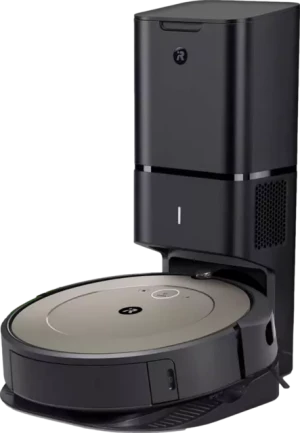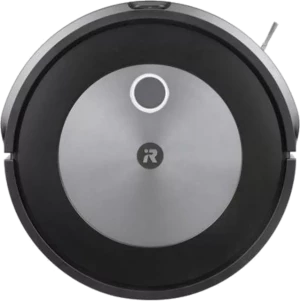Roomba j7+ can clean all floor types, this comes in handy, as different rooms inside your home may have different types of flooring i.e. carpets. If a robot vacuum is advertised able to clean all floor types, it implies that the vacuum is capable to clean several flooring materials without much limitations.
A vacuum's ability to generate a digital map of its cleaning area is one of the commonly asked-for features. This map allows the robot to "understand" the layout of the space. Mapping and navigation can be used for several purposes, for example the Roomba j7+ having the mapping feature can dedicate efficient cleaning in the mapped-out areas keeping out of those that are not.
The Roomba i1 Plus also has the mapping and navigation feature, navigation states how the robot vacuum moves around the cleaning area. Mapping and navigation often go hand in hand to help the vacuum navigate to the mapped-out spaces to be cleaned ignoring those that aren't. Roomba j7+ has an obstacle sensor, such a sensor serves the purpose of detecting and identifying obstacles in the robot's path, this allwos it to navigate around them and avoid collisions.
Many modern robot vacuum cleaners such as the Roomba j7+ are designed to work with Amazon Alexa, which implies that they can be integrated with the Amazon Echo ecosystem and programmed using voice commands. Roomba i1 Plus can also work with Amazon Alexa, keep in mind that you will need an Alexa-enabled device such as an Echo speaker for voice control to work with your robot vacuum. The Roomba j7+ is compatible with Google Assistant, enabling you to control it using voice commands via Google Home devices or the Google Assistant app installed on smartphones and tablets.
Roomba i1 Plus is compatible with Google Assistant, it's advised to verify the level of compatibility with Google Assistant before buying a robot vacuum. The Roomba j7+ has a period of 1 year, this typically range from 1 - 2 years, however some higher-end brands may offer longer warranty periods. The Roomba i1 Plus, at 1 year
has the same warranty period as that of Roomba j7+.
When considering a robot vacuum cleaner, it's important to read and understand the warranty terms and conditions, alongside any limitations or exclusions that may apply.
Roomba j7+'s dustbin capacity is at 0.4L, dustbin capacity determines how much dust, debris, and pet hair the robot vacuum holds before it needs to be emptied. The Roomba i1 Plus, at 0.4L
has the same dustbin capacity as the Roomba j7+
The dustbin capacity varies widely among different robot vacuum models, and the size you choose should depend on your cleaning needs and the size of the area you want to clean. Most robot vacuum cleaners are equipped with sensors and indicators to notify users when the dustbin is full and needs to be emptied.
Roomba j7+ supports this feature, which prevents the robot vacuum from getting clogged thus performance will be maintained as soon as the bin is emptied. Roomba i1 Plus also can indicate when its dustbin is full, for a robot vacuum to alert that it's full can improve the convenience of owning one since it minimizes the need for constant monitoring. Roomba j7+ weighs 3.3kg, robot vacuums are commonly designed to be lightweight and compact for easy maneuverability and portability.
The Roomba i1 Plus, at 4.7kg
weighs more than the Roomba j7+ with a difference of 1.4kg. It's advisable to consider the weight of the vacuum when choosing a model, especially if you plan to carry it up and down stairs
Roomba j7+ has a width of 330mm, aslo known as its cleaning path width, is the width of the area that it can effectively clean in a single pass. The width of a robot vacuum is important as it can affect its efficiency and the duration it takes to clean a room
The Roomba i1 Plus, at 338mm
measures more in width than the Roomba j7+ by 8mm.
A wider cleaning path can cover more ground in a single pass, reducing the time it takes to clean a room. Roomba j7+'s height measures 92mm, here you are considering the measurement from the bottom of the robot vacuum to its highest point. Height is an important consideration, especially if you have furniture with low clearance in your home.
Roomba i1 Plus, at 92mm
has the same height as that of Roomba j7+.
When selecting a robot vacuum, ensure that the robot vacuum can fit under the furniture and navigate effectively in your living space without getting stuck or causing damage. The battery power of a robot vacuum cleaner is a crucial factor that determines how long the vacuum can run on a single charge. Battery capacity is typically measured in milliampere-hours (mAh), Roomba j7+'s battery power is 2,210mAh
The Roomba i1 Plus, at mAh1,800
has less battery power than the Roomba j7+ by only
A bigger capacity implies longer battery life which can be beneficial if you have a large home or if you would like the robot vacuum to complete operations with fewer interruptions to recharge.
The operating time of a robot vacuum cleaner refers to the amount of time the vacuum can clean continuously on a single battery charge before it needs to be recharged. Roomba j7+'s operating time is 1.25h
The Roomba i1 Plus, at 1.25h
has the same operating time as the Roomba j7+
Always plan cleaning cycles around the vacuum's operating time to maximize efficiency and prevent "incomplete work" between charge intervals. Roomba j7+ has a charge time of 5h, the charge time of a robot vacuum cleaner refers to the amount of time it takes for the vacuum's battery to recharge fully after it has been depleted during a cleaning cycle.
The Roomba i1 Plus, at 2.5h
spends lesser time charging than the Roomba j7+ by only 2.5h. Charge time is an important factor to consider when choosing a robot vacuum, as it determines how long you'll need to wait before the vacuum begins its next cleaning cycle. Auto-off is a feature designed to automatically turn off the vacuum after it has completed an operation or when certain conditions occur.
Roomba j7+ has an auto-off feature, which is useful for energy efficiency and battery preservation. Self-emptying bins or automatic dirt disposal systems like the Roomba j7+, are modern robot vacuum models that have the ease of use feature to empty their dustbins automatically. Also, Roomba i1 Plus is self-emptying, have it in mind that self-emptying robot vacuums tend to be on the higher end of the price spectrum due to this advanced feature.
Roomba j7+ has carpet detection, this enables the vacuum to identify and adapt to different floor surfaces, to be specific recognizing when it moves from hard floors like hardwood to areas with carpets. Roomba j7+ supports a smartphone app, that allows you to control and monitor the vacuum remotely through your smartphone or tablet. Both the Roomba i1 Plus and Roomba j7+ have mobile application support, mobile apps enhance your experience by providing convenience, and ease update of features and functionalities.
This feature in robot vacuum cleaners is intended to reduce the likelihood of the robot vacuum becoming stuck while cleaning. Robot vacuums such as the Roomba j7+ are equipped with various sensors and technologies to move around obstacles and avoid getting trapped, but the effectiveness of this feature can vary among different models. Both the Roomba i1 Plus and Roomba j7+ have the "anti-stuck" feature, but clearing clutter, ensuring proper cable management, and creating clear paths for the vacuums helps to further eliminate the chances of getting stuck while cleaning.
Virtual barriers are typically set up and managed through the robot vacuum's mobile app, similar to no-go zones, these barriers are designed to enable you control and restrict where the robot vacuum can and cannot go during cleaning. Both Roomba j7+ and Roomba i1 Plus support virtual barriers, this ability to set virtual barriers is especially useful for homes with areas where the robot vacuum may encounter obstacles. Roomba j7+ has a route mapping feature that enables it to create a map of your space and schedule efficient cleaning routes.
This mapping capability enhances the vacuum's ability to work effectively and systematically. Route mapping is a valuable feature as it makes it possible for robot vacuums such as the Roomba i1 Plus to adapt to the layout of your space to work more efficiently and reduce the possibility of missing certain spots. Voice prompts refer to audible messages that the vacuum states to give you alerts on the different states of the vacuum.
Roomba j7+ has this feature
The Roomba i1 Plus also supports voice prompts, this feature is useful for you who like audible notifications or users who have visual impairments. Auto-docking is a feature in robot vacuum cleaners that refers to the vacuum's ability to autonomously return to its docking station when certain conditions are met such as done with cleaning, battery running low, or any malfunction. Both Roomba i1 Plus and Roomba j7+ support this feature, considered a convenient feature because it makes sure that the robot vacuum maintains its charge and readiness for cleaning with little or no manual intervention.
Most robot vacuum cleaners such as Roomba j7+ come having an "cliff detection" feature. This feature is intended to save the robot vacuum from falling off stairs, ledges, or other elevated surfaces, hence its safety while cleaning. This safety feature that is also available on the Roomba i1 Plus is key in preventing accidents and keeping the robot vacuum from damage.
It gives you peace of mind knowing that the vacuum will not fall down a flight of stairs during its cleaning cycle. Roomba j7+ has this convenient feature, which allows you to set specific days or times of day for the robot vacuum to start working. The scheduling feature in robot vacuums is particularly useful in keeping a consistently clean space with little or no manual intervention.
Roomba i1 Plus too can be scheduled. Roomba j7+ supports Wi-Fi, Wi-Fi-enabled robot vacuums offer several advantages and features, such as remote control, mobile app integration, voice assistant compatibility, and remote monitoring. Also, Roomba i1 Plus supports Wi-Fi, Wi-Fi connectivity enhances the ease and flexibility of robot vacuum use, allowing for more efficient and customized cleaning routines.

